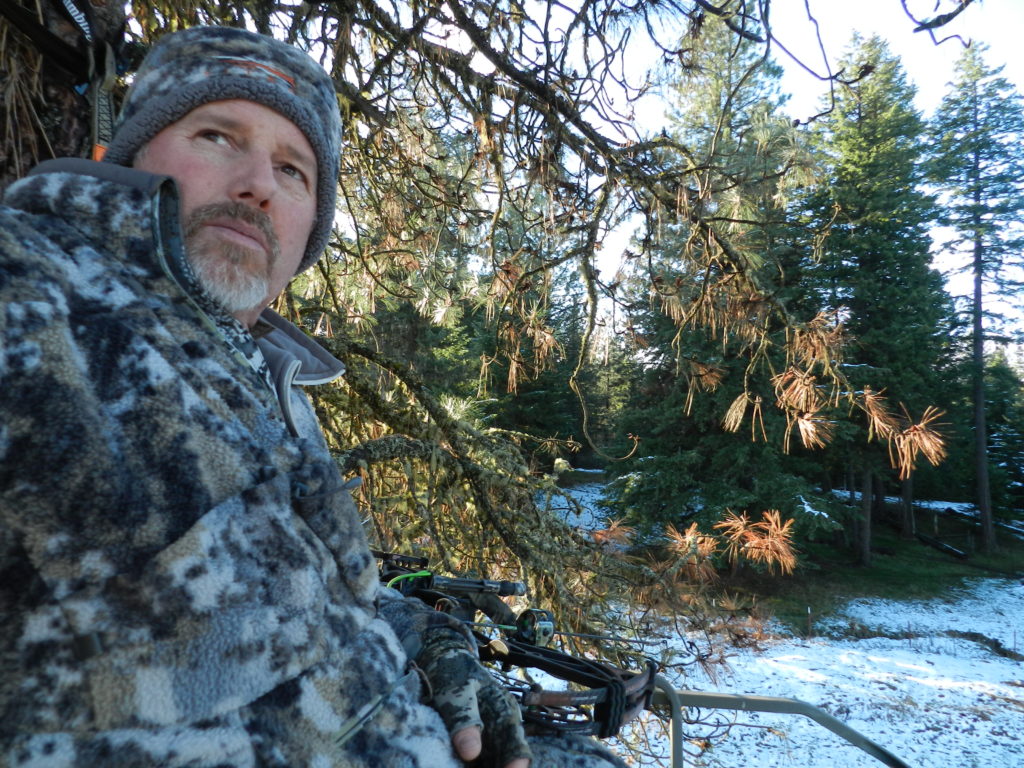
Follow these five golden rules and you can be that guy — you know, that hunter in camp who, no matter where he sits, sees all of the big bucks.
Life isn’t always fair.This is more pronounced when sitting for white-tailed deer. One guy does everything exactly by the book but sees only does and immature bucks. Another walks into unfamiliar woods on a whim, sits on a random stump, lights a cigarette in boredom and shoots the biggest buck of the season. Such realities meant I once hated whitetail hunting.
Cutting my bowhunting teeth by tediously stalking desert muleys, Coues’ deer and elk, it seemed to me that sitting for “Eastern” whitetails was more a game of chance than skill, and I’ve never been particularly lucky. I couldn’t draw a limited tag with 50-50 odds in five tries, for instance, while I have friends who regularly draw the most coveted permits.
In the 30-plus years since I started bowhunting whitetails, I’ve come to think of myself as a reason- ably savvy deer hunter. Luck always drives hunting, but I’d like to think I’ve killed at least a few of my best bucks on purpose. But this hit me hard during a recent South Dakota hunt. Four of us hunted diligently during prime dates in exceptional habitat. One of our group — seemingly quite nonchalantly — passed shots at P&Y-quality bucks daily. He eventually put an arrow through a 150-plus non-typical. The rest of us never so much as saw a mature buck.
It got me thinking. Was this divine intervention? Was this fellow so lucky he should’ve been spending time in one of the local casinos instead of treestands? Or was there something else at work?
GOLDEN RULE NO 1:
STAY WIDE AWAKE
Sitting for whitetails is dominated by long silences, punctuated by very brief moments of intense ecstasy. As a Western bowhunter, whitetails were initially torture, so it’s easy to understand that sitting for long hours presents its own brand of challenge. This comes from two fronts: the challenge of sitting still for long hours, especially true for high-energy types, and at the opposite end of the spectrum, simply staying awake and attentive during ensuing tedium. Beating the former comes with time and experience. The latter, well that can prove more problematic.
Early in my whitetail journey, traveling several time zones eastward, I found it easy to doze off on stand, or at least become completely inattentive, putting in time against forced confinement. Cold doesn’t help, and in large hunting camps there’s the tendency to stay up late shooting the bull and having one too many drinks with the boys.
The question then begs asking: What are you missing during these attention lapses? I’ve long since become completely content during long hours on stand. This might have a lot to do with the fact I hunt near home more often today, having moved to north Idaho’s whitetail country and sleeping in my own bed. But there’s more to it. Even when traveling to hunt today — especially while hunting where potential rewards are great — I’ve become very boring. I drink less and hit the sack at an early hour. When the alarm sounds at 4 a.m. Eastern Standard Time (my soul still being on Pacific Time), I’m ready to roll. I’m also alert and fully engaged while on stand.
Sleep on stand if you wish (and you’re strapped in safely), but know a season-making buck will pass while you’re dozing as surely as a football game’s most exciting play occurs while you’re visiting the men’s room. Being alert is more than being aware of deer sauntering within 30 yards. When I’m fully absorbed, I see bucks passing well out of range, some- times while glassing slowly, allowing me to turn my passive hunt into something proactive (more on that momentarily). In general, during prime hours in good habitat — especially during the rut — it might serve you well to stand while waiting, leaving you better prepared for sudden or fleeting shot opportunities, or bucks arriving from unexpected trajectories.

GOLDEN RULE NO 2:
GET IN, SIT DOWN, SHUT UP
Northern Idaho whitetail hunting has taught me many things the laid-back Midwest did not. We suffer countless dead-still days during the November rut in particular, days when you can hear a twig snap from 100 paces. This also means the smallest noise while slipping into a stand proves cringe-worthy. I see many more deer when I slip into stands silently and organize necessary gear with minimal fuss.
We have so much paraphernalia to manage these days; ozone machines, mini video cameras, calls and rattling antlers, laser rangefinders and optics, even fancy bow hangers. I try to arrange for all such gear while setting up stands, especially hot stands I know will be leaned on heavily for success. I purchase extra mounting brackets for my Ozonics unit and install them in every tree, instead of fighting with that on arrival. Every tree gets a permanent and separate gear and bow hook. My POV camera is attached to my bow (where legal) or quickly installed in the same auger hole each time. A red-hued LED headlight helps speed things along, allowing you to see clearly without spooking nearby game, and to get everything in its place with minimal commotion.
I also attend to small details, such as assuring life-line carabineers or bows on pull-up ropes won’t clang on ladder sections or stands. Too, I clear a clean pull-up path for bows, assuring they won’t hang up or make undue noise. I’ve had more deer than I can count arrive beneath my stands only minutes after hoisting my bow up. Those are deer that would’ve been spooked had I been fussing with equipment. Most of those were does that would assuredly have commenced to snorting, ruin- ing my stand for the remainder of the morning.
GOLDEN RULE NO 3:
IN EARLY, OUT LATE
As the old adage goes, you must be present to win. Furthermore, arriving early assures you’re 100 percent ready for action with the first hints of shooting light, leaving late to assure you don’t miss the arrival of a behemoth buck pushing the legal-hour envelope. I’ve been as guilty as anyone, after a long, boring evening on stand with zero action, calling it quits early and climbing down, certain I’ll miss nothing.
But I can’t help but recall a Kansas buck, one of my most beautiful to date, showing up after I’d gathered my gear, unclipped and started to lower my bow. I got lucky. Twenty more seconds and things would have turned out differently. Now I never leave stands until I can no longer see my pins.
There are invariably mornings when you’re running a little behind schedule, climbing into your stand during legal shooting light. What have you already missed (or bumped) by arriving late? Because “stuff” happens, I make it a routine to arrive at stands at least a half hour before daylight. This assures any deer that are apt to pass my way are well removed, and leaves a margin for error should I take a little longer getting situated.
GOLDEN RULE NO 4:
GLASS, CALL AND COAX
As I hinted earlier, pulling your head into your jacket collar and zoning out means you’re likely missing important movement well away from your stand site. We try to place stands precisely for intimate pass- ing shots, but deer pretty much do what they want. This is part of the foundation of remaining awake and attentive. Use your time on watch to scan the area around your stand with a binocular, paying close attention to what’s going on behind you and afar. A buck passing out of range isn’t out of bounds. He just might come to you with a little coaxing, but you must know he exists before you can try.
I’ve called many bucks from hundreds of yards in open farm country, or just coaxed them out of brush for cleaner shots in thicker vegetation. In better habitats, during rut dates, grunt calls and antlers are standard daypack gear. But even during the pre-rut, or in lesser habitats where lower buck-to-doe ratios curtail aggressive responses to calls, subtle social calls (doe bleats, quiet contact grunts) can bring deer nearer out of social curiosity.
In other cases, paying close attention to deer movement around you can reveal a pattern initiating a strategic stand shift. My biggest buck to date came because I’m a chronic glasser, something born out of my Western bowhunting background. I spied him scraping on the same fence corner, many hundreds of yards away, on two occasions. I moved a stand there one afternoon and killed that buck two hours later in a gathering storm.

GOLDEN RULE NO 5:
BE BOW READY
Bringing a bow to bear, even before the draw cycle begins, can be a conspicuous maneuver. It’s quite tempting, especially during rut dates and resulting all-day sits, to leave your bow on a hook while you kick back comfortably. But hang your bow too inconveniently and the added time required to stealthily grasp it, even the added motion required, can cost you shots at cruising bucks.
Bow hangers are nifty, but I will use one only when I can install and swing it into position to minimize movement while grabbing my bow. Otherwise it’s best to keep your bow in your lap, at minimum. During prime hours — actually difficult to determine during rut dates — keep your bow in hand, ready for action. Obviously, an arrow is nocked (one of the advantages of bow hangers) and when possible, the release aid engaged. I use a closed- sear, T-handle release clipped to the string loop and left in place, which allows grab-and-shoot responses to sudden appearances of bucks.
A basic screw-in tree step (wrapped in padding tape), even smaller gear hooks, may suffice as bow hangers. These are excellent options for securing daypacks and calls but less so for bows because they normally place the bow against the tree trunk where you must turn conspicuously to reach it. When possible, while trimming out a stand tree, I attempt to leave a branch in place as an elbow-rest/bow-hook holder, situating the bow within easy arm’s reach while hung from a centralized riser cutout.
Better yet, articulated bow hangers offer a better solution. Prime examples include Team Realtree E-Z Hangers, with a self-tapping lag-screw base and two or three swiveling sections. They are easily installed and adjusted to place your bow exactly where it’s needed for quick access with minimal, attention-grabbing movement. They are offered in 13- and 23-inch two-section and Deluxe 34-inch three-section models. I was once a big believer in leaving my bow in my lap, but now depend on E-Z Hangers while stand hunting.
Luck is still a huge part of the whitetail game and always will be. I followed these rules in South Dakota and still went home empty handed. But day in and day out, year after year, remaining on point, posed as if action is immediately imminent, keeping close tabs on what is going on around you, will pay large dividends. Get your sleep, believe in every stand you place (or move it somewhere else) and forever anticipate the impending appearance of deer, and your stand hunting will prove more successful. Though it never hurts to wear your lucky hat, and pray.
— Patrick Meitin is a widely traveled bowhunter and former big-game hunting guide. He hails from northern Idaho.


